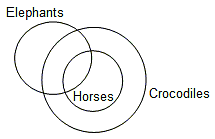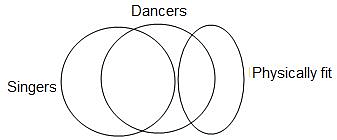APSET Paper 1 Mock Test - 2 - AP TET MCQ
30 Questions MCQ Test APSET Mock Test Series 2025 - APSET Paper 1 Mock Test - 2
Direction: Following table shows the percentage distribution of votes amongst five candidates A, B, C, D and E and total votes cast (in hundred) during the year 2013 to 2018 of collage presidential election. Study the data carefully and answer the questions based on it.
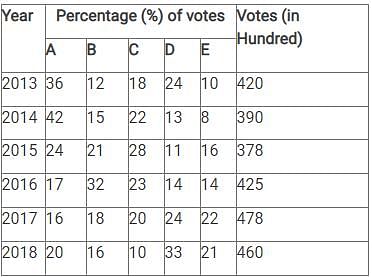
Q. If, out of the total number of voters in 2016 who fevered D, only 40 % could successfully cast their votes and remaining was unsuccessful. Find the number of voters who appeared to cast their votes in favour of D:

The communication which happens outside the realm of interpersonal communication is called:
| 1 Crore+ students have signed up on EduRev. Have you? Download the App |
Match List - I with List-II and select the correct answer from the code given below:
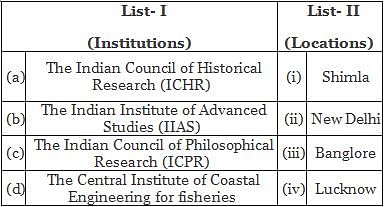

Directions: Answer the given question based on the following table.
Marks obtained by 6 candidates A, B, C, D, E and F:
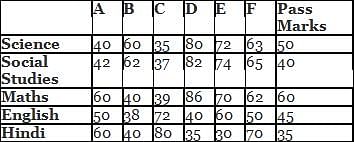
Q. Which of the following candidates did not fail in any of the subjects?
Given below are two statements:
Statement I: Nitrification results in an increase in effluent ammonia toxicity
Statement II: Denitrification reduces nitrate to nitrogen gas using bacteria
In light of the above statements, choose the most appropriate answer from the options given below:
Directions: Read the following passage and answer the given questions:
Recently, India witnessed a severe power shortage due to high demand and the non-availability of adequate coal supply. An energy deficit of more than 100 million units has been recorded during the month of April 2022. Rajasthan, Haryana, Punjab, UP, Bihar, and Madhya Pradesh were the most affected states. India is the second largest country in terms of population, and the usage of electricity is increasing day by day. In today's India, electricity has reached even the remotest areas, and people are reaping its benefits. Electricity is critical to the overall development of society and the country, including technological development. However, technological advances require more electricity. The power requirement of many industries, such as railroads, agriculture, and domestic use, is increasing day by day.
The advancement of technology and the resurgence of economic activity following the COVID-19 disruptions increased the demand for power. In April 2022, the average daily energy requirement increased to 4,512 million units, as opposed to 3,941 million units in April 2021, registering a growth of 14.5%. The use of electricity has increased in many industries, including railways, agriculture, and households. India's thermal power plants are also running well below their capacity, which could have managed this demand increase by increasing thermal generation. To address the problem of the power crisis in India, there is a need to change our planning and policies from ones that mainly manage shortages to ones that are flexible. Policies should be formulated with a focus on long-term structural solutions that address delivery, financial viability, and a robust mechanism for resource planning. The focus should be on ensuring that power plants operate efficiently. To address power shortages, a strategic approach to the low-cost energy transition, such as renewable energy and opportunities for diversification in the energy mix, is critical. For long-term power security, greater attention should be paid to accelerating generation from renewable energy sources.
Q. Choose the most appropriate option that describes the meaning of the term ‘renewable energy’ as used in the passage.
Directions: Read the following passage carefully and answer the given question.
The catalytic fact of the twentieth century is uncontrollable development, consumerist society, political materialism, and spiritual devaluation. This inordinate development has led to the transcendental ‘second reality’ of sacred perception that biologically transcendence is a part of human life. As the century closes, it dawns with imperative vigour that the ‘first reality’ of enlightened rationalism and the ‘second reality’ of the beyond have to be harmonised in a worthy state of man. The defacto values describe what we are, they portray the ‘is’ of our ethic, they are est values (Latin est means is). The ideal values tell us what we ought to be, they are esto values (Latin esto ‘ought to be’). Both have to be in the ebb and flow of consciousness. The ever new science and technology and the ever-perennial faith are two modes of one certainty, that is the wholeness of man, his courage to be, his share in Being.
The materialistic foundations of science have crumbled down. Science itself has proved that matter is energy, processes are as valid as facts, and affirmed the non-materiality of the universe. The encounter of the ‘two cultures’, the scientific and the humane, will restore the normal vision, and will be the bedrock of a ‘science of understanding’ in the new century. It will give new meaning to the ancient perception that quantity (measure) and quality (value) coexist at the root of nature. Human endeavours cannot afford to be humanistically irresponsible.
Q. The 'de facto' values in the passage mean
Directions: Read the below information carefully and answer the question that follow.
The bar graph shows revenue (in lakhs) of a food company that sells different kinds of food items:

Q. What was the number of years in which there was an increase in revenue from at least two categories?
The average age of 5 teachers is 28 years. If one teacher is excluded, then the mean gets reduced by 2 years. The age of the excluded teacher is
What among the following is the major factor of biodiversity change?
‘Fly ash’ produced in thermal power plants is an eco-friendly resource for use in:
1) agriculture as micro-nutrient
2) wasteland development
3) dam and water holding structures
4) brick industry
Choose the correct answer from the code given below:
Directions: Read the following passage carefully and answer the question.
The popular view of towns and cities in developing countries and of urbanisation process is that despite the benefits and comforts it brings, the emergence of such cities connotes environmental degradation, generation of slums and squatters, urban poverty, unemployment, crimes, lawlessness, traffic chaos etc. But what is the reality? Given the unprecedented increase in urban population over the last 50 years from 300 million in 1950 to 2 billion in 2000 in developing countries, the wonder really is how well the world has coped, and not how badly.
In general, the urban quality of life has improved in terms of availability of water and sanitation, power, health and education, communication and transport. By way of illustration, a large number of urban residents have been provided with improved water in urban areas in Asia’s largest countries such as China, India, Indonesia and Philippines. Despite that, the access to improved water in terms of percentage of total urban population seems to have declined during the last decade of 20th century, though in absolute numbers, millions of additional urbanites have been provided improved services. These countries have made significant progress in the provision of sanitation services too, together, providing for an additional population of more than 293 million citizens within a decade (1990-2000). These improvements must be viewed against the backdrop of rapidly increasing urban population, fiscal crunch and strained human resources and efficient and quality-oriented public management.
Q. Which of the following is/are not considered the indicator(s) of urban quality of life?
Direction: The following consists of a question and two statements numbered I and II given below it. You have to decide whether the data provided in the statements are sufficient to answer the question.
What is Rohit's rank in the class?
Statement I. Rohit's rank is 24 less than Nandani's rank.
Statement II. Archana's rank is 38 more than Rohit's rank. Nandani's rank is 10 less than Archana's rank.
Which part of the Constitution of India is known as "Code of Administrators"?
______ is committing to the factual information to memory.
Directions: Read the following passage carefully and answer the question.
It should be remembered that the nationalist movement in India, like all nationalist movements, was essentially a bourgeois movement. It represented the natural historical stage of development, and to consider it or to criticise it as a working-class movement is wrong. Gandhi represented that movement and the Indian masses in relation to that movement to a supreme degree, and he became the voice of Indian people to that extent. The main contribution of Gandhi to India and the Indian masses has been through the powerful movements which he launched through the National Congress. Through nation-wide action he sought to mould the millions, and largely succeeded in doing so, and changing them from a demoralised, timid and hopeless mass, bullied and crushed by every dominant interest, and incapable of resistance, into a people with self-respect and self-reliance, resisting tyranny, and capable of united action and sacrifice for a larger cause.
Gandhi made people think of political and economic issues and every village and every bazaar hummed with argument and debate on the new ideas and hopes that filled the people. That was an amazing psychological change. The time was ripe for it, of course, and circumstances and world conditions worked for this change. But a great leader is necessary to take advantage of circumstances and conditions. Gandhi was that leader, and he released many of the bonds that imprisoned and disabled our minds, and none of us who experienced it can ever forget that great feeling of release and exhilaration that came over the Indian people.
Gandhi has played a revolutionary role in India of the greatest importance because he knew how to make the most of the objective conditions and could reach the heart of the masses, while groups with a more advanced ideology functioned largely in the air because they did not fit in with those conditions and could therefore not evoke any substantial response from the masses.
It is perfectly true that Gandhi, functioning in the nationalist plane, does not think in terms of the conflict of classes, and tries to compose their differences. But the action he has indulged and taught the people has inevitably raised mass consciousness tremendously and made social issues vital. Gandhi and the Congress must be judged by the policies they pursue and the action they indulge in. But behind this, personality counts and colours those policies and activities. In the case of very exceptional person like Gandhi, the question of personality becomes especially important in order to understand and appraise him. To us he has represented the spirit and honour of India, the yearning of her sorrowing millions to be rid of their innumerable burdens, and an insult to him by the British Government or others has been an insult to India and her people.
Q. Gandhi played a revolutionary role in India because he could
In a certain code, CLOCK is written as KCOLC. How would STEPS be written in that code?
Which of the following is not one of the prime health risks associated with greater UV radiation through the atmosphere due to depletion of stratospheric ozone?
Directions: Read the following passage carefully and answer the question.
The phrase “What is it like?“ stands for a fundamental thought process. How does one go about observing and reporting on things and events that occupy segments of earth space? Of all the infinite variety of phenomena on the face of the earth, how does one decide what phenomena to observe? There is no such thing as a complete description of the earth or any part of it, for every microscopic point on the earth’s surface differs from every other such point. Experience shows that the things observed are already familiar, because they are like phenomena that occur at home or because they resemble the abstract images and models developed in the human mind.
How are abstract images formed? Humans alone among the animals possess language; their words symbolise not only specific things but also mental images of classes of things. People can remember what they have seen or experienced because they attach a word symbol to them.
During the long record of our efforts to gain more and more knowledge about the face of the earth as the human habitat, there has been a continuing interplay between things and events. The direct observation through the senses is described as a percept; the mental image is described as a concept. Percepts are what some people describe as reality, in contrast to mental images, which are theoretical, implying that they are not real.
The relation of Percept to Concept is not as simple as the definition implies. It is now quite clear that people of different cultures or even individuals in the same culture develop different mental images of reality and what they perceive is a reflection of these preconceptions. The direct observation of things and events on the face of the earth is so clearly a function of the mental images of the mind of the observer that the whole idea of reality must be reconsidered.
Concepts determine what the observer perceives, yet concepts are derived from the generalisations of previous percepts. What happens is that the educated observer is taught to accept a set of concepts and then he/she sharpens or changes these concepts during a professional career. In any one field of scholarship, professional opinion at one time determines what concepts and procedures are acceptable, and these form a kind of model of scholarly behaviour.
Q. The relation of Percept to Concept is
Under GATS, higher education policies are to be framed by which of the following Departments?
If you get an opportunity to teach a visually challenged student along with normal students, what type of treatment would you like to give him in the class?
McGrath earned a profit of Rs. 300 by selling 100 kg of a mixture of A and B types of rice at a total price of Rs. 1,100. What was the proportion of A and B types of rice in the mixture if the cost prices of A and B are Rs. 10 and Rs. 5 per kg, respectively?
Given below are two statements, one labelled as Assertion (A) and the other as Reason(R). Read and examine the statements carefully and choose the correct option.
Assertion (A): Some carbonaceous aerosols may be carcinogenic.
Reason (R): They may contain polycyclic aromatic hydrocarbons (PAHs).
Direction: Choose the correct option with the help of Assertion (A) and Reason (R).
Assertion (A): The initial messages to students in the classroom by a teacher need not be critical to establishing interactions later.
Reason (R): More control over the communication process means more control over what the students are learning.
Directions: Read the following passage carefully and answer the following question.
All historians are interpreters of text if they be private letters, Government records or parish birthlists or whatever. For most kinds of historians, these are only the necessary means to understanding something other than the texts themselves, such as a political action or a historical trend, whereas for the intellectual historian, a full understanding of his chosen texts is itself the aim of his enquiries. Of course, the intellectual history is particularly prone to draw on the focus of other disciplines that are habitually interpreting texts for purposes of their own, probing the reasoning that ostensibly connects premises and conclusions. Furthermore, the boundaries with adjacent subdisciplines are shifting and indistinct, the history of art and science both claim a certain autonomy, partly just because they require specialised technical skills. Both can also be seen as part of a wider intellectual history, as is evident when one considers. For example, the common stock of knowledge about cosmological beliefs or moral ideals of a period.
Like all historians, the intellectual historian is a consumer rather than a producer of ‘methods’. His distinctiveness lies in which aspect of the past he is trying to illuminate, not in having exclusive possession of either a corpus of evidence or a body of techniques. That being said, it does seem that the label ‘intellectual history’ attracts a disproportionate share of misunderstanding.
It is alleged that intellectual history is the history of something that never really mattered. The long dominance of the historical profession by political historians bred a kind of philistinism, an unspoken belief that power and its exercise was ‘what mattered’. The prejudice was reinforced by the assertion that political action was never really the outcome of principles or ideas that were ‘more flapdoodle’. The legacy of this precept is still discernible in the tendency to require ideas to have ‘licensed’ the political class before they can be deemed worthy of intellectual attention, as if there were some reasons why the history of art or science, of philosophy or literature, were somehow of interest and significance than the history of Parties or Parliaments. Perhaps in recent years, the mirror-image of this philistinism has been more common in the claim that ideas of any one systematic expression or sophistication do not matter, as if they were only held by a minority.
Q. What is philistinism?
Directions: In the following question, there are two statements followed by two conclusions I and II. You are to take the two statements to be true even if they seem to be at variance from the commonly known facts and then decide which of the conclusions logically follow(s) from the two statements.
Statements:
Some elephants are horses.
All horses are crocodiles.
Conclusions:
I. No crocodile is an elephant.
II. Some elephants are crocodiles.
Directions: Read the data given in the following bar-graph carefully and answer the following question.
The bar-graph shows the net profit of a multinational company ABC (in Cr) from 2001-2002 to 2008-2009.
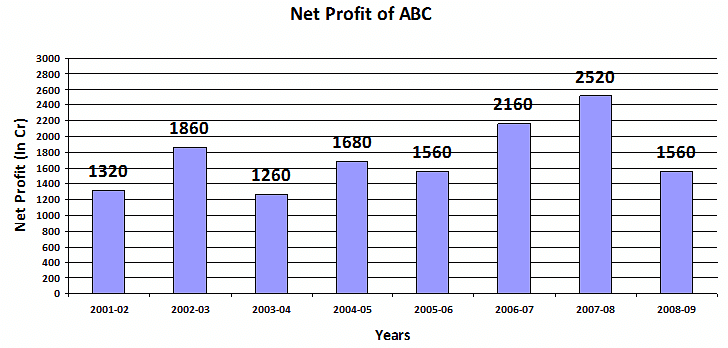
Q. What is the ratio of the number of years having more net profit than the average profit to the number of years having lesser net profit than the average profit of the company?
Directions: Read the given passage carefully and answer the following question:
Heritage conservation practices improved worldwide after the International Centre for the Study of the Preservation and Restoration of Cultural Property (ICCROM) was established with UNESCO’s assistance in 1959. The inter-governmental organisation with 126 member states has done a commendable job by training more than 4,000 professionals, providing practice standards, and sharing technical expertise. In this golden jubilee year, as we acknowledge its key role in global conservation, an assessment of international practices would be meaningful to the Indian conservation movement. Consistent investment, rigorous attention, and dedicated research and dissemination are some of the positive lessons to imbibe. Countries such as Italy have demonstrated that prioritising heritage with significant budget provision pays. On the other hand, India, which is no less endowed in terms of cultural capital, has a long way to go. Surveys indicate that in addition to the 6,600 protected monuments, there are over 60,000 equally valuable heritage structures that await attention. Besides the small group in the service of Archaeological Survey of India, there are only about 150 trained conservation professionals. In order to overcome this severe shortage, the emphasis has been on setting up dedicated labs and training institutions. It would make much better sense for conservation to be made part of mainstream research and engineering institutes, as has been done in Europe.
Increasing funding and building institutions are the relatively easy part. The real challenge is to redefine international approaches to address local contexts. Conservation cannot limit itself to enhancing the art-historical value of the heritage structures, which international charters perhaps overemphasise. The effort has to be broad-based: It must also serve as a means to improving the quality of life in the area where the heritage structures are located. The first task, therefore, is to integrate conservation efforts with sound development plans that take care of people living in the heritage vicinity. Unlike in western countries, many traditional building crafts survive in India, and conservation practices offer an avenue to support them. This has been acknowledged by the Indian National Trust for Art and Cultural Heritage charter for conservation but is yet to receive substantial state support. More strength for heritage conservation can be mobilised by aligning it with the green building movement. Heritage structures are essentially eco-friendly and conservation could become a vital part of the sustainable building practices campaign in future.
Q. Which of the following statements best describe(s) the major challenge faced in the implementation of international conservation policies?
Directions: Choose the correct alternative that will complete the series below.
DEB, IJG, NOL, ?, XYV
Given below are two premises (A and B). Four conclusions are drawn from them. Select the code that states validly drawn conclusion(s) (taking the premises individually or jointly).
Premises:
A. Some dancers are physically fit.
B. Some singers are dancers.
Conclusions:
1. Some singers are physically fit.
2. Some dancers are singers.
3. Some physically fit persons are dancers.
4. Some physically fit persons are singers.
|
60 tests
|





